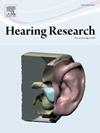Prevention of aminoglycoside-induced outer hair cell loss by silencing CaMKKβ in an acute mouse model
IF 2.5
2区 医学
Q1 AUDIOLOGY & SPEECH-LANGUAGE PATHOLOGY
引用次数: 0
Abstract
The use of ototoxic drugs remains a common cause of acquired hearing loss worldwide. Among them, aminoglycoside antibiotics are still widely used in clinical practice. Although the pathological mechanisms underlying aminoglycoside-induced hearing loss have been extensively studied, no clinically effective pharmacological treatment is currently available to prevent such ototoxicity. Our previous study demonstrated that calcium overload and activation of the Ca²⁺/calmodulin-dependent protein kinase kinase (CaMKK) pathway play a critical role in noise-induced hearing loss. In this study, we assessed the activation of CaMKKβ in an acute ototoxicity model induced by kanamycin plus furosemide (KM + FU). We silenced CaMKKβ using small interfering RNA in young adult CBA/J mice and AAV-mediated shRNA in FVB/NJ mice to determine whether reduction of CaMKKβ in hair cells could prevent KM + FU-induced outer hair cell loss and hearing loss. Remarkably, both silencing approaches provided significant prevention of KM + FU-induced outer hair cell loss. Moreover, RNA interference targeting CaMKKβ did not alter the permeability of the stria vascularis or the uptake of kanamycin through mechanoelectrical transduction channels in hair cells. These findings suggest that CaMKKβ is a promising therapeutic target for prevention of aminoglycoside-induced hearing loss in acute model.
在急性小鼠模型中通过沉默CaMKKβ预防氨基糖苷诱导的外毛细胞损失
使用耳毒性药物仍然是世界范围内获得性听力损失的常见原因。其中氨基糖苷类抗生素仍广泛应用于临床。虽然氨基糖苷性听力损失的病理机制已被广泛研究,但目前尚无临床有效的药物治疗方法来预防这种耳毒性。我们之前的研究表明,钙超载和Ca 2 + /钙调素依赖性蛋白激酶激酶(CaMKK)途径的激活在噪声性听力损失中起着关键作用。在这项研究中,我们评估了CaMKKβ在卡那霉素加呋塞米(KM + FU)诱导的急性耳毒性模型中的激活情况。我们在年轻的成年CBA/J小鼠中使用小干扰RNA和在FVB/NJ小鼠中使用aav介导的shRNA来沉默CaMKKβ,以确定毛细胞中CaMKKβ的减少是否可以预防KM + fu诱导的外毛细胞损失和听力损失。值得注意的是,这两种沉默方法都能显著预防KM + fu诱导的外毛细胞损失。此外,靶向CaMKKβ的RNA干扰不会改变血管纹的通透性,也不会改变毛细胞通过机电转导通道对卡那霉素的摄取。这些发现表明,CaMKKβ是预防急性氨基糖苷性听力损失的一个有希望的治疗靶点。
本文章由计算机程序翻译,如有差异,请以英文原文为准。
求助全文
约1分钟内获得全文
求助全文
来源期刊

Hearing Research
医学-耳鼻喉科学
CiteScore
5.30
自引率
14.30%
发文量
163
审稿时长
75 days
期刊介绍:
The aim of the journal is to provide a forum for papers concerned with basic peripheral and central auditory mechanisms. Emphasis is on experimental and clinical studies, but theoretical and methodological papers will also be considered. The journal publishes original research papers, review and mini- review articles, rapid communications, method/protocol and perspective articles.
Papers submitted should deal with auditory anatomy, physiology, psychophysics, imaging, modeling and behavioural studies in animals and humans, as well as hearing aids and cochlear implants. Papers dealing with the vestibular system are also considered for publication. Papers on comparative aspects of hearing and on effects of drugs and environmental contaminants on hearing function will also be considered. Clinical papers will be accepted when they contribute to the understanding of normal and pathological hearing functions.
 求助内容:
求助内容: 应助结果提醒方式:
应助结果提醒方式:


